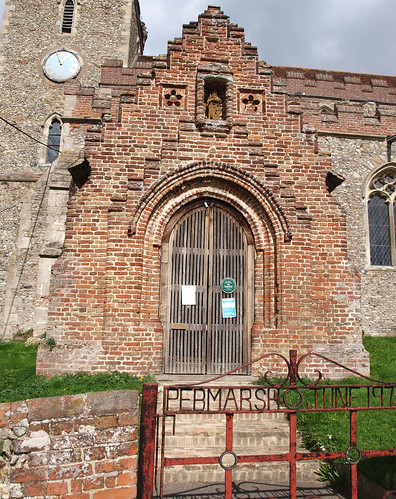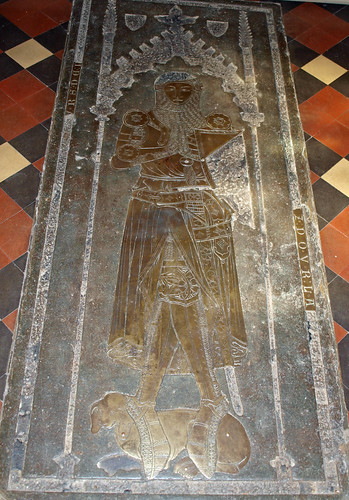St John the Baptist is situated on a mound on the east side of the valley through which flows the brook, known locally as ‘The Peb’. The oldest part of the church is the tower, the east side of which shows the roof line of an earlier building and is built in 3 stages of flint rubble with limestone corners, the walls of the lower stage being 1 foot thicker than the upper stages.
The main body of the church, including the aisles, was built at the beginning of the 14th century. The construction is of flint rubble with the walls being 30 inches thick. The Church is built on a slope so the north side is higher than the south and the east higher than the west. This gives a Tardis effect, from the south entrance it seems quite a small church but once you enter it's huge.
The window sills appear to be the same height from the ground when viewed from the outside but the north windows are considerably higher from the inside of the church.
The porch over the south door is of Tudor brick, the unweathered condition of the carving around the door arch suggests this is a replacement of an earlier one.
The east wall of the chancel is not flint rubble, but of lath and plaster. The sedilla has only two arched seats and the eastern most is partly within the wall. There is no Piscina and this all indicates that the chancel has been shortened by at least 6 feet and the floor appears to have been lowered as it is impossible to sit in the sedilla.
Extensive repairs and restoration were carried out to the North West corner of the Church in 1905 and at the same time the interior plaster was removed and the flints ribbon pointed.
The chancel door has two steps down to floor level and in front of the Altar is the Grade 1 listed brass of Sir William Fitzralph circa 1323 which is one of the the glories of this church, the other being the porch.
St John is an oddity - a straightforward looking Norman building with a peculiar Tudor porch, an oddly Jacobean looking steeple and a vast interior all perched up on a knob of a mound.
The porch and brass sets it apart from the norm.
ST JOHN THE BAPTIST. A C14 church. The W tower came first, see its lower windows. Nave, aisles and chancel followed, all with Dec windows, the most fanciful being the N aisle E window. The arcades have piers with semicircular shafts to the arches and semi-polygonal ones to the nave (cf. e.g. St Peter, Colchester, and St Gregory, Sudbury, across the Suffolk border). The arches are double-chamfered. The Sedilia are the most ornate piece, of two seats only, but meant to be carried on; with crockets, finials, and head-label-stops. In the early C16 the W tower was completed in red brick, with blue diapers, battlements, and stunted pinnacles. An C18 cupola on top. Of the C16 and also in brick the embattling of the church and the unusually elaborate brick S porch, with a blank stepped gable over the entrance and another stepped gable above. In a niche a statuette of St John by Alec Miller. - PULPIT. Re-used traceried panels, perhaps from bench ends. - STAINED GLASS. C14 bits in chancel and N aisle windows. E window by Clayton & Bell, 1879. N aisle E window by Hugh Easton, 1934. So much is said (and done) nowadays against Victorian glass that one should consider seriously whether Clayton & Bell’s is not more legitimately stained glass than Mr Easton’s which is always reminiscent of line drawings daintily water coloured. - PLATE. Cup of 1567; Paten on foot of 1697. - MONUMENT Sir William Fitzralph d. c. 1323; The earliest and one of the most important brasses in the county. Large figure, cross legged, with a hood of mail.
ST JOHN THE BAPTIST. A C14 church. The W tower came first, see its lower windows. Nave, aisles and chancel followed, all with Dec windows, the most fanciful being the N aisle E window. The arcades have piers with semicircular shafts to the arches and semi-polygonal ones to the nave (cf. e.g. St Peter, Colchester, and St Gregory, Sudbury, across the Suffolk border). The arches are double-chamfered. The Sedilia are the most ornate piece, of two seats only, but meant to be carried on; with crockets, finials, and head-label-stops. In the early C16 the W tower was completed in red brick, with blue diapers, battlements, and stunted pinnacles. An C18 cupola on top. Of the C16 and also in brick the embattling of the church and the unusually elaborate brick S porch, with a blank stepped gable over the entrance and another stepped gable above. In a niche a statuette of St John by Alec Miller. - PULPIT. Re-used traceried panels, perhaps from bench ends. - STAINED GLASS. C14 bits in chancel and N aisle windows. E window by Clayton & Bell, 1879. N aisle E window by Hugh Easton, 1934. So much is said (and done) nowadays against Victorian glass that one should consider seriously whether Clayton & Bell’s is not more legitimately stained glass than Mr Easton’s which is always reminiscent of line drawings daintily water coloured. - PLATE. Cup of 1567; Paten on foot of 1697. - MONUMENT Sir William Fitzralph d. c. 1323; The earliest and one of the most important brasses in the county. Large figure, cross legged, with a hood of mail.
PEBMARSH. Its post office is Tudor and it has many Tudor farms and houses, among them Stanley Hall with a moat and carved beams; Worldsend with two original studded doors; and Greathouse Farm, a modern house with two barns and a granary of the 16th and 17th centuries. But we come to the church for the great attraction of Pebmarsh, for among its treasures is one of the very few brasses in England dating from the first half of the 14th century. There are believed to be only about 16 of them, and this one has the distinction of being among the very earliest to show the plate armour of those days. It is a fine picture of Sir William Fitzralph who fought in the wars of Edward the First and helped to hammer the Scots, dying about 1323. He is lying cross-legged, has armour and chain mail, and wears a long coat tied at the waist. His sword is in an ornamental scabbard, and his feet rest on a hound.
The church is mostly the work of 14th century builders, but from the 16th century come its brick parapets on the tower and aisle, a porch with a niche and a rose, and tie-beams in the nave roof. There is a beautiful 14th century doorway with four animal heads, a modern door with medieval ironwork, a 15th century bell, a pulpit with woodwork 500 years old, two l7th century chairs carved with flowers and leaves and cherubs, and an old chest. In the windows are many scraps of glass as old as the church, shields and foliage, flowers and leopard faces, and a little man standing.
Flickr set.


No comments:
Post a Comment